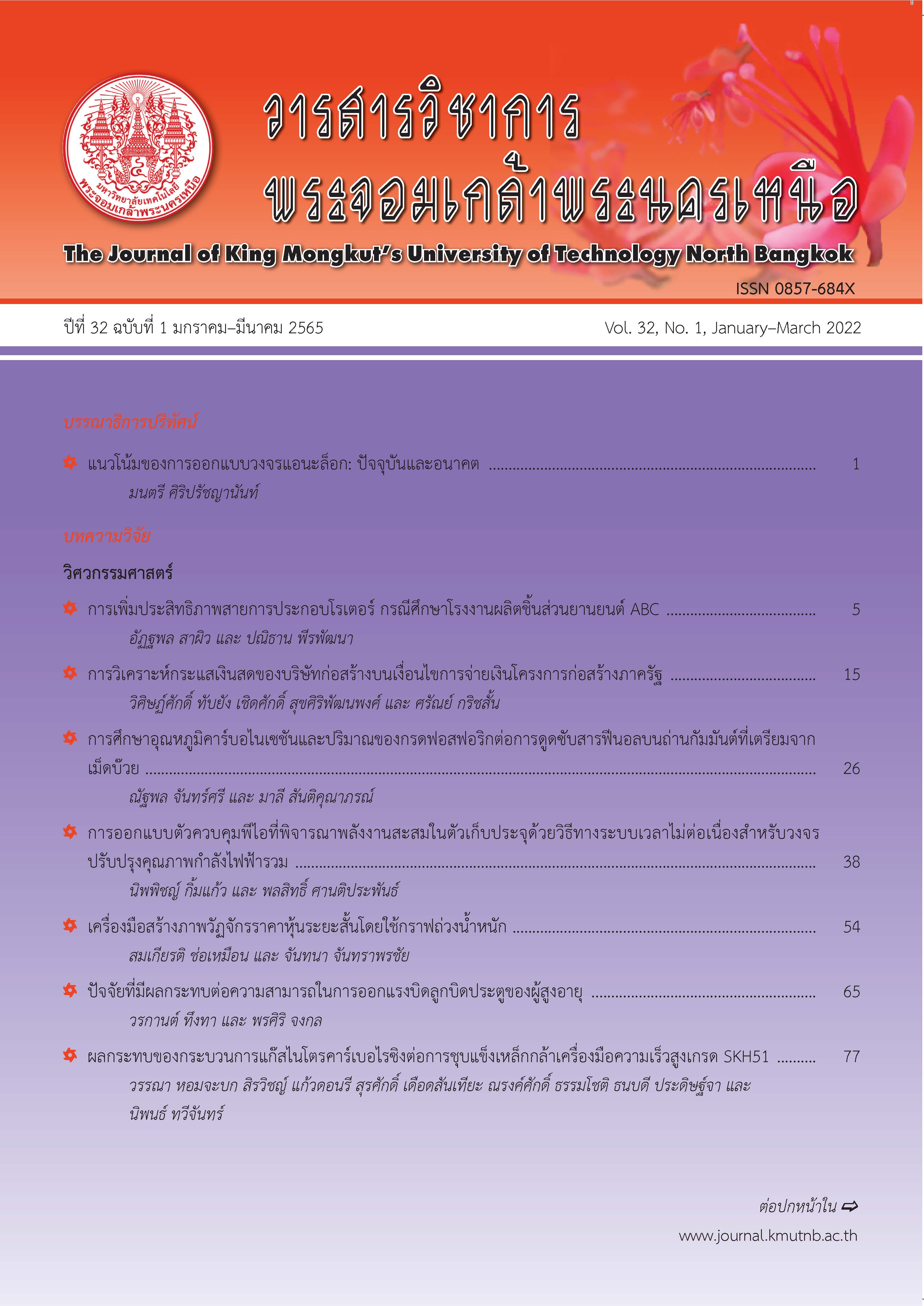การวิเคราะห์กระแสเงินสดของบริษัทก่อสร้างบนเงื่อนไขการจ่ายเงินโครงการก่อสร้างภาครัฐ
Main Article Content
บทคัดย่อ
การวิเคราะห์กระแสเงินสดโครงการก่อสร้างมีความสำคัญอย่างยิ่ง การวิเคราะห์กระแสเงินสดเข้าโดยทั่วไปใช้วิธีการคำนวณต้นทุนจากค่าใช้จ่ายที่ผู้รับเหมาใช้ในการดำเนินโครงการในแต่ละช่วงของการกำหนดจ่ายเงินงวดงาน อย่างไรก็ตามสัญญาโครงการก่อสร้างภาครัฐส่วนใหญ่กำหนดการจ่ายเงินงวดงานโดยผู้รับเหมาต้องดำเนินกิจกรรมที่กำหนดให้แล้วเสร็จก่อนการขอเบิกเงินงวดงาน ซึ่งหากไม่พิจารณาถึงเงื่อนไขการจ่ายเงินดังกล่าวอาจทำให้บริษัทผู้รับเหมาเกิดสภาวะการขาดแคลนเงินสดในระหว่างดำเนินโครงการ บทความนี้มีวัตถุประสงค์เพื่อวิเคราะห์กระแสเงินสดของบริษัทก่อสร้างตามเงื่อนไขการจ่ายเงินโครงการก่อสร้างภาครัฐ และเปรียบเทียบผลการวิเคราะห์กับวิธีทั่วไป โดยการเก็บรวบรวมข้อมูลเงื่อนไขการจ่ายเงินของบริษัทผู้รับเหมา และเงื่อนไขการจ่ายเงินของเจ้าของโครงการ จำนวน 3 บริษัท ซึ่งประกอบด้วย บริษัทขนาดเล็กขนาดกลาง และขนาดใหญ่ ด้วยวิธีการสัมภาษณ์เบื้องลึกและวิเคราะห์เอกสาร และนำข้อมูลมาวิเคราะห์กระแสเงินสดออกกระแสเงินสดเข้า และกระแสเงินสดโครงการ การวิเคราะห์กระแสเงินสดเข้าแบ่งออกเป็น 2 รูปแบบ คือ รูปแบบที่ 1 วิธีการคำนวณแบบทั่วไป และรูปแบบที่ 2 วิธีการคำนวณแบบเงื่อนไขการจ่ายเงินงวดงาน ผลการศึกษาพบว่ามูลค่ากระแสเงินสดเข้าของโครงการในแต่ละช่วงเวลาของทั้ง 3 บริษัท มีความแตกต่างกัน เนื่องจากกำหนดการจ่ายเงินงวดงานที่ไม่สม่ำเสมอจึงทำให้บางช่วงเวลาไม่มีกระแสเงินสดเข้า มูลค่าเงินเบิกเกินบัญชีสูงสุดที่คำนวณด้วยรูปแบบที่ 2 มากกว่ารูปแบบที่ 1 ร้อยละ 16, 2.46 และ 1.83 สำหรับบริษัทผู้รับเหมาขนาดเล็ก ขนาดกลาง และขนาดใหญ่ ตามลำดับ จากผลการวิเคราะห์แสดงให้เห็นว่าบริษัทผู้รับเหมาก่อสร้างต้องระมัดระวังในการวิเคราะห์กระแสเงินสดโครงการอย่างมาก โดยเฉพาะอย่างยิ่งบริษัทขนาดเล็กที่มีโอกาสเกิดสภาวะขาดสภาพคล่องอย่างรุนแรงและนำไปสู่การเลิกกิจการได้
Article Details
บทความที่ลงตีพิมพ์เป็นข้อคิดเห็นของผู้เขียนเท่านั้น
ผู้เขียนจะต้องเป็นผู้รับผิดชอบต่อผลทางกฎหมายใดๆ ที่อาจเกิดขึ้นจากบทความนั้น
เอกสารอ้างอิง
[2] S. Slatter, Corporate Recovery: Successful Turnaround Strategies and Their Implementation. Singapore: Penguin, 1984.
[3] J. Lowe, “Insolvency in the UK construction industry,” Journal of Financial Management of Property and Construction, vol. 2, no. 1, pp. 83–110, 1997.
[4] D. Arditi, A. Koksal, and S. Kale, “Business failures in the construction industry,” Construction and Architectural Management, vol. 7, no. 2, pp. 120–132, 2000.
[5] W. P. Hughes, P. Hillebrandt, and J. R. Murdoch, Financial Protection in the UK Building Industry. Reading: Spon, 1998.
[6] The data of juristic person registration. (2019). Annual Report of Department of Business Development, Bangkok, Thailand. [Online] (in Thai). Available:https://www.dbd.go.th/news_view.php?nid=469416662
[7] E. I. Altman, “The success of business failure prediction models,” Journal of Banking and Finance, vol. 8, no. 2, pp. 171–198, 1984.
[8] A. M. Elazouni and F. G. Metwally, “Financebased scheduling: tool to maximize project profit using improved genetic algorithms,” Journal of Construction Engineering and Management, vol. 131, no. 4, pp. 400–412, 2005.
[9] S. Ahmed and H. Ossama, “A multi-objective model for enterprise cash flow management,” presented at the CSCE Annual Conference, Laval (Greater Montreal), Canada, Jun 12–15, 2019.
[10] S. M. R. Alavipour and D. Arditi, “Optimizing financing cost in construction projects with fixed project duration,” Journal of Construction Engineering and Management, vol. 144, no. 4, pp. 04018012, 2018.
[11] H. L. Chen, “Development of a systematic integration approach for multi-level cost flow prediction and management,” Ph.D. dissertation, University of Florida, 2002.
[12] H. L. Chen, W. J. O’Brien, and Z. J. Herbsman, “Assessing the accuracy of cash flow model: The significance of payment conditions,” Journal of Construction Engineering and Management, vol. 131, no. 6, pp. 669–676, 2005.
[13] T. Wisitsak and B. Vacharapoom, “The effect of payment conditions on cash flows of construction projects,” Ladkrabang Engineering Journal, vol. 30, no. 1, pp. 73–78, 2013 (in Thai).
[14] R. D. Gilbreath, Managing Construction Contracts: Operational Controls for Commercial Risks. John Wiley & Sons Inc, 1992.
[15] H. Xie, J. Zheng, Y. Zhang, and H. Li, “Effects of payment delays at two links in payment chains on the progress of construction projects: System dynamic modeling and simulation,” Sustainability, vol. 11, no. 15, pp. 4115, 2019.
[16] N. Dayanand, “Scheduling payment in projects: An optimization framework,” Ph.D. dissertation, Camegie Mellon University, 1995.
[17] A. Elazouni, “Heuristic method for multi-project finance-based scheduling,” Construction Management and Economics, vol. 27, no. 2, pp. 199–211, 2009.
[18] M. A. Abido and A. M. Elazouni, “Multiobjective evolutionary finance-based scheduling: Entire projects portfolio,” Journal of Computing in Civil Engineering, vol. 25, no. 1, pp. 85–97, 2011.
[19] R. K. Yin, Case Study Research: Design and Methods. Beverley Hills, CA: Sage, 1989.
[20] T. Au and C. Hendrickson, “Profit measures for construction projects,” Journal of Construction Engineering and Management, vol. 112, no. 2, pp. 273–286, 1986.

